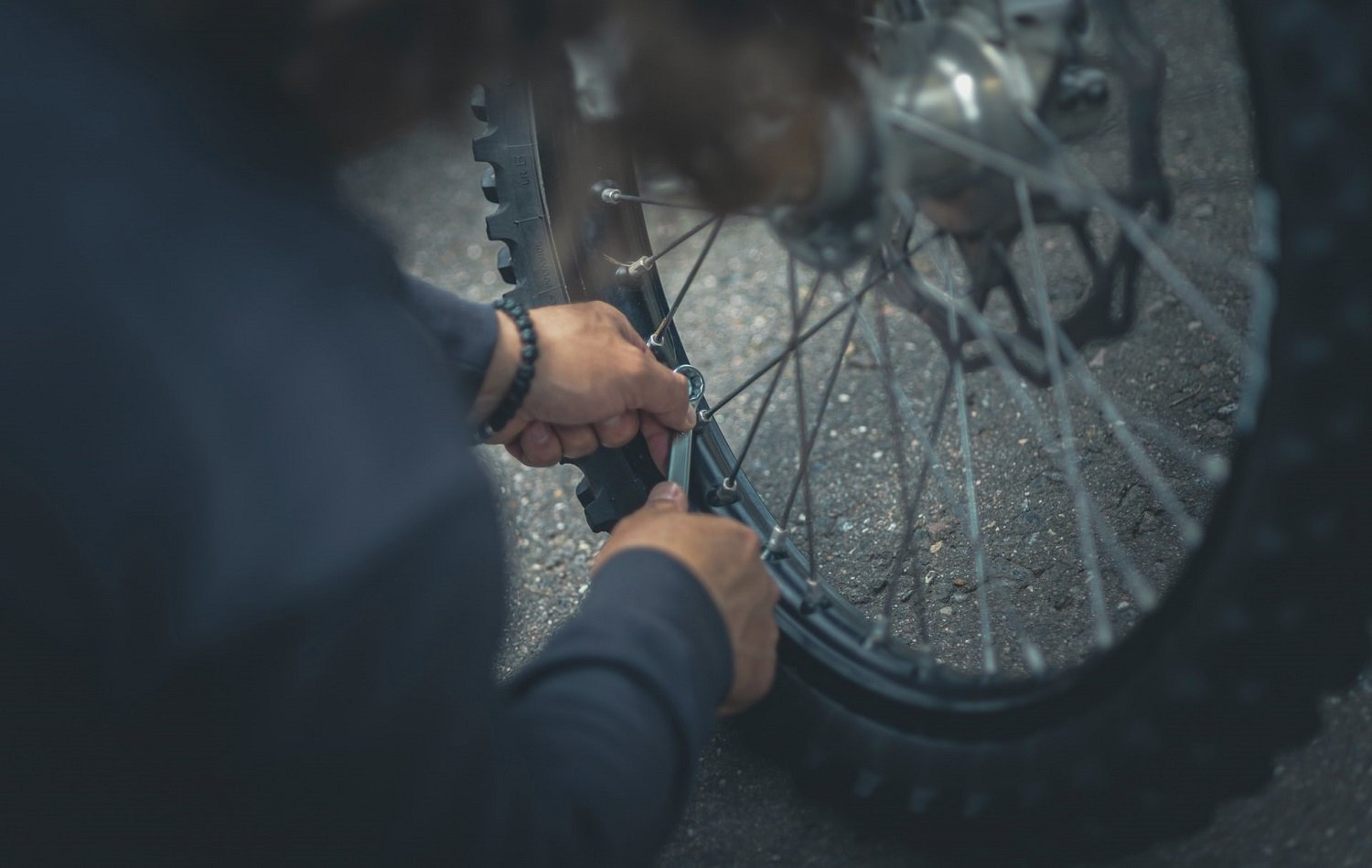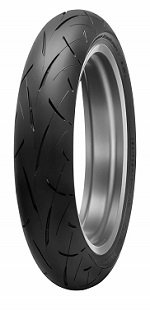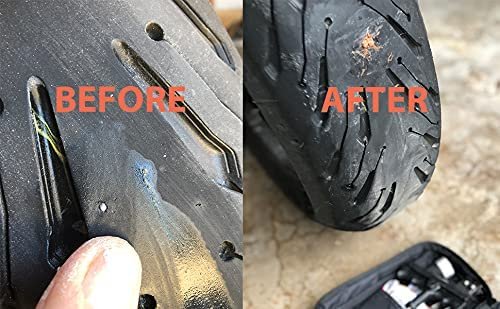How To Prevent Motorcycle Flat Tires
Updated on | By Mohit Chauhan

A puncture in a motorcycle tire can happen faster than you might think. If you think that a punctured car tire is a big nuisance, a flat tire on a motorcycle is a much more serious problem; since there is no spare wheel. And in case it does happen to you, you may have to push your bike to the nearest service center or contact a tow truck driver.
Statistics show that on an average, a rider has to expect a flat tire every 5 years. But these types of breakdowns can be a real source of danger, especially when riding at a full speed on the highway. But even if the air escapes slowly, a flat tire is still a nightmare. In worst cases, you may have no choice but to change the tire.
In today’s post, we will discuss common causes of motorcycle tire puncture and how to prevent it from happening.
Reasons for a flat tire
The most common cause of a flat tire is simply material wear and tear. Over the years, tires gradually lose their properties as they endure rigorous abuse caused by external factors like gravel, rocks, aggressive riding style, and climate. This may lead to pinching or a completely flat tire if left unattended.
An unusual pulling to one side, wobbling of the handlebar or an abrupt noise from the wheel are some of the indications before your tire completely flats out. It is therefore advisable to completely replace the tires every 8 to 10 years (even if they appear to be in a good condition) and to visit a workshop quickly if you notice any slight signs of damage.
An accident involving an impact with the roadside curb can also lead to a flat tire since these kinds of collision damages the wheel rim or the valve of the tire.
Listed below are some of the most common reasons for flat tires of a motorcycle:
Puncture by a sharp object
The primary cause of a flat tire is damage caused by pointed or sharp objects on the road. Common suspects are broken glass, nails or sharp-edged metal scraps. Avoid riding over rubble, debris or rubbish; you never know what might get stuck on your tire.
Faulty valve
Damaged or faulty valves can also be a reason for flat tires. If a valve has been damaged or soiled, air can escape from it gradually. Whenever you check the air pressure of your tires, make sure that the valves are working properly and are not showing any signs of damage. If you have your doubts, it is best to consult a mechanic.
Worn or cracked tire
Even a minor looking wear can have dangerous consequences. An unnoticed crack on the tire wall can cause the tire to burst if it is subjected to high loads. You should therefore check the integrity of your tires every now and then and consult a workshop if you are unsure.
Damaged tire bead
The tire bead is located where the tire wall adjoins the rim. An inadequate tire pressure generally causes misalignment between the bead and the rim. With time, the friction caused by the rubbing of rim against the bead can damage the tire or create minor cracks which may cause air to leak out. If you suspect such damage, pour some water over your tire and check for bubbles. If you notice bubbles over the edges, it is highly likely that air is leaking out from the edges of your tire.
Tire detached from rim
This type of damage usually occurs when the wheel suddenly crosses a pothole at a high speed. The strong impact causes the tire to detach slightly from the rim. This leads to pressure loss, which only becomes noticeable after a while.
Inadequate air pressure
Inadequate tire pressure is also one of the common reasons for a motorcycle tire puncture. If the tire pressure is too low, the tires can overheat (a high speed drive for around 20 minutes can heat your tire up to 120 °Celsius in case of low air pressure). This may lead to sudden burst in worst cases. We all have seen scraps of tire lying on the side of highways, this is usually due to excessive heat build up inside the tire due to inadequate air pressure.
Similarly, over inflation can increase the wear and tear of your motorcycle tire and distort the shape of the tire. Furthermore, an over inflated tire leads to less traction and may lead to hydroplaning in case of downpour.
Aggressive riding
Riding aggressively or carelessly over gravel or unpaved road can lead to the formation of cracks or holes in your tires, which, like all other types of damages, can lead to a flat tire.
Obsolete tires
The life of any motorcycle tire solely depends on the motorcyclist. The riding style, storage techniques, and frequency of maintenance determines the life expectancy of a motorcycle tire. A reckless style of riding may cause the tire to go bald in a year, whereas, a disciplined riding considerably adds years to your tire’s life. It is important to keep a check at your tires and replace them if necessary. Besides, if you are riding with the same tire for more than 10 years, it is best to replace them with a new one, even if the treads are intact.
You can find out the age of your tires by referring to the DOT serial numbers that are mentioned on the side wall of your tires. This number constitutes the week and the year of manufacture. For example, the digit code 3221 stands for the 32nd calendar week of 2021.
Read more: When to replace motorcycle tires
Motorcycle sitting idle for a long time
If a motorcycle is sitting idle for a prolonged amount of time (months or even years), then along with the critical engine components, deformities on the tire may form as well. The situation is aggravated if the storage temperature is suboptimal. Moreover, the risk of burst increases considerably on the affected tire.
What are the signs of a flat tire?
The handling of the motorcycle changes, when a tire leaks out air. The typical symptoms of loss in pressure on the front tire can be determined by observing the behavior of handle bar while maneuvering. If the handle bar is wobbly and a little tight than usual, either the tire pressure is less or about to go flat.
A rear tire, on the other hand, will be difficult to maneuver around the curves. You will also feel sluggishness and a slight jiggle indicating that the surface of the road is in contact with the rim.
If your bike shows any of these handling characteristics, it is recommended to stop as quickly as possible. The tire bead of a tubeless motorcycle tire due to insufficient air pressure can detach from the rim. In worst cases, the tire can detach completely from the rim and cause fatal accidents.
Advice: Foreign objects that are stuck in the tire are often noticeable in the form of clicking noise while riding. As soon as you notice this clicking noise, it is best to inspect your tire and take necessary actions.
What to do in the event of a flat tire?
The most important thing is to keep calm. In most cases, a motorcycle accident is not caused by a flat tire, but by the wrong behavior of the motorcyclist. If you notice that the tire is flat or showing symptoms of a puncture, it is best to stop immediately near the side of the road. In some cases, for example on the highway, it may be necessary to cover a short amount of distance before getting to the side of the road; in this case it is advisable to proceed with the utmost caution, at extremely low speeds.
If you have a hazard warning indicator installed, now is the time to turn them on. If not, use hand gestures to convey the traffic behind you about your situation.
Jerky steering movements or heavy braking should be avoided as the motorcycle will behave abruptly.
Once you are stationary, set up a warning triangle at least 50 meters away from the breakdown (150 meters on a highway) and inspect the puncture.
Advice: It is absolutely impossible to continue your journey when you have a flat tire. And if you continue to ride, a flat tire can completely compromise the rim of the bike. Riding with a flat tire, in fact, will inexorably ruin the tire itself which, in the event of a puncture, can be repaired at a reduced cost. But that’s not all: in addition to the tire, the uneven weight distribution of a punctured bike can compromise the suspension as well.
Tips to prevent flat tires on a motorcycle
A flat tire is a part of every motorcyclist’s life. However, there are a few things you can do to prevent this from happening. Our tips will save you from annoying moments that ruin your tour and delay your journey.
1) Choose the right tire
It is in the nature of a motorcyclist that they tend to go for the fastest, lightest and most grippy tire. However, due to their special rubber compound, light tires are usually more flexible and therefore less durable than thicker models. Sharp pebbles, glass or other tipped objects can dig into the rubber more easily and cause a puncture.

Fortunately, you can find a lot of durable tires in the market that are light as well as fast. Some of them include; Dunlop Roadsport, Michelin Commander III Touring, Bridgestone M59, and Pirelli Scorpion Rally.
2) Maintain an ideal air pressure
The most common reason for your tire to go flat is due to incorrect air pressure. Tires are often insufficiently inflated because the air pressure is not checked regularly. Maintaining an ideal air pressure is the best way to get the most out of your tires, thereby saving a lot of money on replacement and puncture kits.
Many riders believe that it is generally not necessary to inflate your tire as recommended by the brand. We would not like to contradict any opinion, as every rider has their own riding style. But this riding style will come with consequences. Insufficient tire pressure just slightly below the recommended value can lead to poor handling behavior, reduced directional stability, and short longevity of tire. If the pressure drops even further, the tire can overheat, leading to a sudden burst.
To minimize any kind of risk, you must regularly inspect the air pressure and make it a habit to do so every time you embark on a multi-day tour.
3) Check your tires regularly
Although it is wise to regularly check your motorcycle tires for foreign objects, it is often neglected or taken casually. Either you quickly jump on your bike to meet up with your fellow riders or you you’re already too late to inspect anyway.
Do yourself a favor and don’t be negligent on this point. Just because you didn’t have a flat tire on your last ride doesn’t mean that you won’t get one in future. A simple check can help prevent your nightmare from becoming a reality. A quick but thorough look over the surface of your tire or a careful feel with your fingers is usually enough to locate any foreign objects. It would be ideal if you can do this activity right after reaching your destination. So next time you can ride with a peace of mind and you don’t run the risk of forgetting the tire check or neglecting it because of time constraints.
4) Watch out for potholes
Always keep an eye out for potholes or other dangers that could result in a flat tire. Don’t just look a few meters ahead; instead look out as far as you can to prepare yourself beforehand. This allows you enough reaction time to plan your way out in case of a pothole or related dangers.
Even when riding in a group, you should always keep an eye on the road and not just depend on the group leader. If one of the riders in your group accidentally hits a pothole, it is obvious the entire group will have to wait till the time the tire is repaired, which is annoying as well as time consuming.
5) Be prepared for emergency
While riding at a fast pace, sometimes avoiding a pothole becomes inevitable. At times like these, it is best to loosen your grip slightly and let the wheel adjust to the shock. Additionally, make sure you are not forcing your weight on the handlebars; this will only increase the density of the impact on your tires that will further worsen the situation.
As a preventive measure, it is best to work on your riding skills and practice emergency braking or steering. If you have mastered your bike well, you can try to swerve around the pothole, but be careful of the traffic behind you.
6) Damage repair
If a flat tire is inevitable and the air is leaking out gradually, the damage must be repaired. You have to be very meticulous and careful when repairing it.
You must first check carefully whether the culprit is still in the tire. Run your fingers over the surface of the tire to check for any pointy objects. This will help you to rule out the possibility if any foreign body is still stuck to your motorcycle tire.

Once the tire has been cleared of the foreign object, the next step is to check the damage. In most cases the foreign objects create a small hole that can be repaired within minutes using any kind of repair kits.
Once you have repaired your tire, check if the tire is secured properly on the rim bed and the valve is intact. Before you start riding again, rotate your tires and check for any bulges or any other kind of damage. When everything looks satisfactory, ride towards your nearest service station and inflate your tire to the right air pressure.
7) Go for tubeless tires
Tubeless tires have been on the market for several years now. They have long been part of everyday life for the adventure touring community. The main advantage of these tires is their resistance to getting punctured (to some extent). On one hand, this is of course due to the fact that a tube is no longer required that could run out of air due to a blow. On the other hand, tubeless tires can be repaired without any assistance in case you are stuck in the middle of nowhere.
What is the optimal pressure for a motorcycle tire?
The optimal air pressure for your bike is determined by various factors. The absolute maximum limit is the maximum pressure written on the sidewall of the tire, which you should never exceed for safety reasons. Higher pressure means (at least on smooth surfaces like new asphalt) lower rolling resistance and better puncture protection. However, lower pressure in the tires offers more comfort, as the tire can absorb impacts better and has more hold on the ground, adhering better to surfaces.
As a general rule, the wider the tire, the less pressure is needed. Narrow road bike tires require very high pressure to roll down the road without punctures, while the much wider and stronger tires of many adventure touring bikes require much less pressure.
What is the right time to replace your old motorcycle tire?
Old tires are typically worn tires that have a poor grip and a high chance of getting flat. Of course depending upon the riding style, the tire may have to be replaced more frequently, but under normal circumstances, it is advisable to change your motorcycle tires every ten years, even if they appear in good condition and have not yet reached the statutory wear limit.
According to Michelin, once your tires are 5 years old, it is best to visit a specialist at least once a year to have your tires inspected.
Bottom Line
Avoiding motorcycle punctures is all a matter of common sense. Aggressive riding, heavy braking, or burnouts are habits that cause the tires to wear out considerably and, above all, more quickly.
Often, and especially before you embark on a journey, it is important to ask your mechanic to look at the tires. Surely, between these checks, you are minimizing the chance of flat tire.
Finally, and by all means, go see your mechanic in case you need to replace any of the tires. Disassembly, repair and assembly requires a specialist.
Pamper your tires, show your love, and you will eventually end up saving a lot of money!




